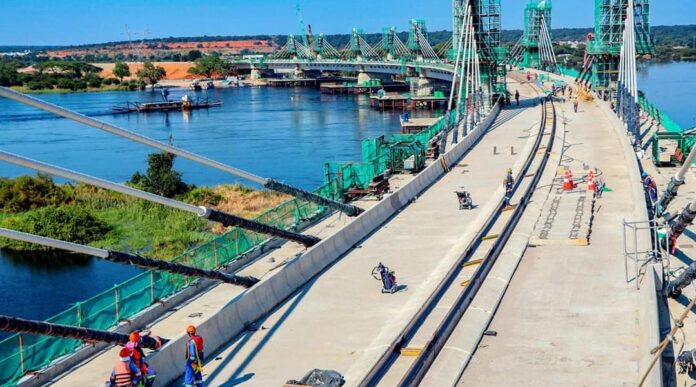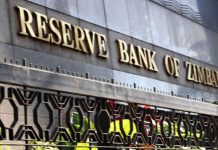Oscar Nkala
On 10 May, the presidents of Botswana and Zambia officially opened the new Kazungula Bridge and one-stop border posts, aimed at ushering in more traffic. The bridge is part of the Trans-African Highway Network and the North-South corridor link between the SADC and COMESA free trade areas.
The presence of three more presidents from the Southern Africa Development Community (SADC) underlined the significance of the opening ceremony.
Zambia and Botswana funded the $259m infrastructure project. The plan was to unplug the Zambezi River barrier and link the Democratic Republic of Congo, Tanzania and Zambia to South Africa and Namibia via Botswana.
Prior to the construction of the bridge, a small pontoon boat was used to ferry traffic between Zambia and Botswana across the Zambezi River.
This slowed movement of traffic which resulted in congestion at the borders. Truckers would spend up to 14 days on transit formalities, so they abandoned the route through Botswana and instead chose to go through Zimbabwe to get to South Africa.
Kazungula project
According to Botswana’s Government, the Kazungula Bridge and one stop border post (OSBP) was designed with future inter-regional transport linkages in mind:
“The project has three components. Package one is the 923 metre-long bridge, which was designed as a road and rail bridge to accommodate a future railway line to link the Mosetse-Kazungula line in Botswana to the Kazungula-Livingstone line in Zambia.”
The bridge includes a single railway track and one-stop-border post (OSBP) facilities on either side of the bridge.
Zambia’s President Edgar Lungu, who spoke during the opening of the facilities on 10 May, said Kazungula would strengthen relations between the two countries and boost trans-African development through trade and industrialisation.
“This OSBP will lower the cost of doing business and boost regional trade, job creation and tourism. It is a critical milestone in the development of the North-South Transport Corridor as it facilitates access to international markets with linkages to major seaports,” Lungu said.
Botswana’s President Mokgweetsi Masisi said Kazungula would promote African economic development and integration through transport and trade links:
“It goes without saying that goods from Eswatini, Lesotho, South Africa and Namibia as well as Kenya, the DRC, Tanzania and Kenya will use this bridge in the spirit of the African Continental Free Trade Agreement (AfCFTA).”
Economic significance
The Kazungula Bridge is a component of the Trans-African Highway Network and the North-South corridor link between the SADC and COMESA free trade areas.
Analysts expect the surge in traffic flow to revive the Kazungula corridor since it serves as an alternative link for traffic (from East and Central Africa) to the port of Durban.
On 11 May, the African Development Bank (AfDB) said Kazungula “leverages” on various infrastructure development initiatives aimed at unlocking inter-continental trade.
“Kazungula leverages the AfDB’s Industrialisation Strategy for Africa and aligns with the SADC Regional Infrastructure Development Master Plan; the Revised SADC Regional Indicative Strategic Development Plan; the Tripartite Trade and Transport Facilitation Programme; the New Economic Partnership for African Development and the AU Program for Infrastructure Development in Africa.”
Zimbabwe loses out?
Prior to the opening of the bridge, debate was already raging in Zimbabwe, with citizens opining that Kazungula would replace Beitbridge as the largest inland port in Africa.
Analysts said unless Zimbabwe upgraded its dilapidated road network and resolved transit bottlenecks at ports of entry, traffic on the North-South Corridor would be forced to shift to Kazungula.
Wengayo Nhau, president of the Tourism Business Council of Zimbabwe (TBCZ), has expressed fear that Kazungula will enable visitors from South Africa to bypass Zimbabwe and see the Victoria Falls from Zambia.
“The bridge is changing tourism. Zimbabwe is no longer the only link between South Africa and Sub-Saharan Africa and tourists can drive through Botswana and reach Zambia without passing through Zimbabwe,” he says.
After delays in Beitbridge, tourists in Zimbabwe must contend with tollgates, potholes and multiple police and vehicle inspection roadblocks.
Analyst Eddie Cross says truckers on the North-South Corridor will opt for Kazungula to avoid the inconvenience of transiting through Zimbabwe.
“Kazungula can make a significant impact on trade-flows to and from Zambia and the DR Congo. Zimbabwe has a very poor road network and too many taxes, so truckers will be tempted to go through Kazungula.”
George Charamba, the presidential spokesman, said Zimbabwe will have to pay for its stake in Kazungula. “Until payment is done, Kazungula remains jointly owned by Botswana and Zambia,” he said on Twitter on 11 May.
He added that Kazungula would never replace Beitbridge as the regional transport hub.
“Kazungula is one of several routes servicing the North-South Corridor. Anyone going through Kazungula to avoid Zimbabwe will contend with an extra 200 kilometers. No sensible logistician can ignore that spatial fact.”
The East African newspaper said Kazungula offers an alternative to the chaos in Beitbridge:
“The (Kazungula) bridge will facilitate intra-regional freight by allowing truckers to by-pass the notorious Beitbridge border post, which is perennially congested with vehicles spending days waiting to cross.”
Zimbabwe has since embarked on a roads and ports rehabilitation program including a $300m upgrade of the Beitbridge border post and reconstruction of the Beitbridge-Chirundu highway which leads to East and Central Africa. – Africa Report











